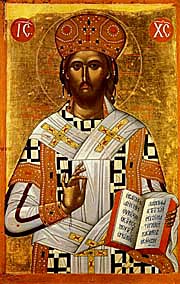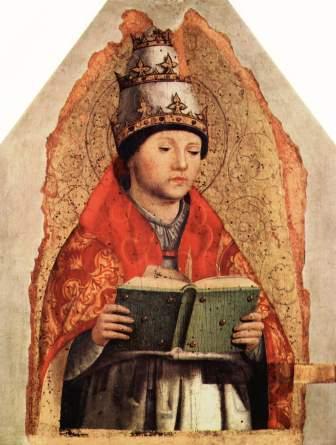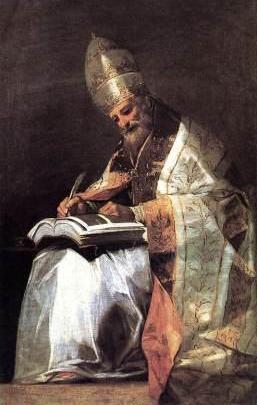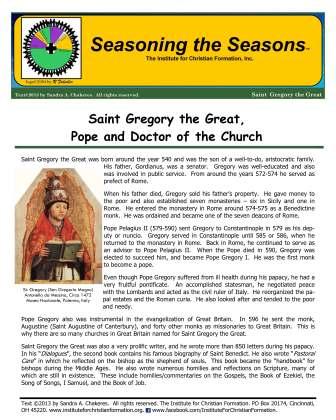The Institute for Christian Formation

Saint Gregory the Great, Pope & Doctor of the Church
Feast Day (Memorial): September 3
Saint Gregory the Great was born around the year 540 and was the son of a well-to-do, aristocratic family. His father, Gordianus, was a senator. Gregory was well-educated and also was involved in public service. From around the years 572-574 he served as prefect of Rome.
When his father died, Gregory sold his father’s property. He gave money to the poor and also established seven monasteries – six in Sicily and one in Rome. He entered the monastery in Rome around 574-575 as a Benedictine monk. He was ordained and became one of the seven deacons of Rome.
Pope Pelagius II (579-590) sent Gregory to Constantinople in 579 as his deputy or nuncio. Gregory served in Constantinople until 585 or 586, when he returned to the monastery in Rome. Back in Rome, he con-
St. Gregory (San Gregorio Magno)
Antonello da Messina, Circa 1472
Museo Nazionale, Palermo, Italy
tinued to serve as an advisor to Pope Pelagius II. When the Pope died in 590, Gregory was elected to succeed him, and became Pope Gregory I. He was the first monk to become a pope.
Even though Pope Gregory suffered from ill health during his papacy, he had a very fruitful pontificate. An accomplished statesman, he negotiated peace with the Lombards and acted as the civil ruler of Italy. He reorganized the papal estates and the Roman curia. He also looked after and tended to the poor and needy.
St. Gregory the Great (San Gregorio el Grande)
Francisco Goya, 1797
Museo Romantico, Madrid, Spain
Pope Gregory also was instrumental in the evangelization of Great Britain. In 596 he sent the monk, Augustine (Saint Augustine of Canterbury), and forty other monks as missionaries to Great Britain. This is why there are so many churches in Great Britain named for Saint Gregory the Great.
Saint Gregory the Great was also a very prolific writer, and he wrote more than 850 letters during his papacy. In his “Dialogues”, the second book contains his famous biography of Saint Benedict. You can read this here. He also wrote “Pastoral Care” in which he reflected on the bishop as the shepherd of souls. This book became the “handbook” for bishops during the Middle Ages. He also wrote numerous homilies and reflections on Scripture, many of which are still in existence. These include homilies/commentaries on the Gospels, on the Book of Ezekiel, on the Song of Songs, on I Samuel, and on the Book of Job.
Saint Gregory the Great is known for his reform of the Liturgy. Gregorian chant is named for him, as it was thought (though this is sometimes questioned) that he compiled and arranged some of these chants. Because of this he is known as the patron saint of music.
Pope Gregory I died on March 12, 604. He was considered a saint almost immediately following his death. In the year 1295, Pope Boniface VIII proclaimed Saint Gregory the Great a Doctor of the Church. Along with Saints Ambrose, Augustine, and Jerome, he is considered one of the four great Doctors of the Western Church.
The following video, from the Apostleship of Prayer in 2008, provides a nice reflection on
In March of 2012, Pope Benedict XVI and the Archbishop of Canterbury celebrated Ecumenical Vespers at the Monastery of San Gregorio al Celio in Rome, the home of Saint Gregory the Great and the monastery from which Pope Gregory chose Augustine and his forty monks and sent them to bring the Gospel to the Angles in the 6th century. You can read the homily of the Archbishop of Canterbury, on this occasion,here, and the homily of Pope Benedict XVI here. Both provide a wonderful ecumenical perspective on the legacy of Saint Gregory the Great.
We celebrate Saint Gregory the Great’s feast day (Memorial) on September 3, the date he was ordained Bishop of Rome in 590. In art he is often depicted with the papal tiara and a dove representing the Holy Spirit. He also was the first pope to use the title, "servant of the servants of God" in reference to the papacy. Celebrate Gregory’s feast day by listening to Gregorian Chant and enjoying an Italian pastry with an English cup of tea!
Follow us on Facebook to keep up to date with our news and newest resources!
Saint Gregory, along with some lovely images of him.


Click on the image above to download our ICF handout on Saint Gregory the Great.
